This installment of my recce series was unintended. I had planned to talk about weapons in the gear article. However. I just kept writing and writing, and writing, and realizing I hadn’t said what I wanted to say. So I broke out into two articles. It buys me an extra week of content, and it lets me more fully explore the concept of the recce rifle and discuss other recce patrol guns, which I’m sure you won’t mind.
The Recce Team | Recce Gear Loadout | Recce Weapons | Recce Team Insertion | Patrolling Skills | Individual Skills | Patrol Base Ops
This article contains affiliate links.
If you’re enjoying this series please consider supporting Swift | Silent | Deadly on Patreon. Each one of these recce articles represents somewhere between 8 and 20 hours of hard work. You support is greatly appreciated!
Debunking the Necessity of a “Recce Rifle”
Right out the gate I’m probably going to hurt some feelings. Let’s talk about the Recce Rifle versus the recce rifle. If that sounds confusing, let’s talk about the difference between the formalized concept of a “big-R” Recce Rifle, and a rifle used for recce. Let’s start with the former.
The concept of the Recce Rifle has become a popular one over the past few years. It’s certainly a valid concept as originally conceived for the Navy SEALS (even having its own Wikipedia page!). As described in this outstanding article, the Recce Rifle is essentially designated marksman rifle, or a “sniper M4” as Kyle Defoor termed it. Many civilian writers have adopted this term and some have watered it down to “general purpose carbine” but this parts ways with the original intent of the Recce Rifle concept.
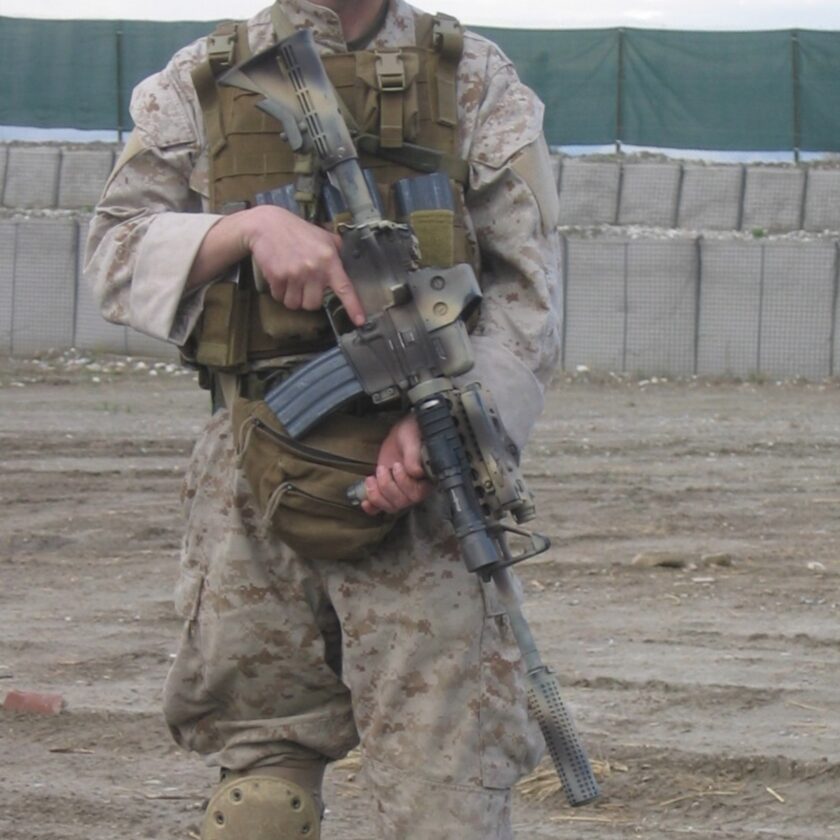
These rifles were intended to function in a specialized role: for use by a sniper in a dynamic role as a member of a recon team. The Recce Rifle wasn’t intended to be the standard-issue patrol rifle for all members of a recce element. One or maybe two guys in the team would carry them. The rest of the team usually (but admittedly not always) carries rifles used for recce. That is M4s, usually of the SOPMOD Block I (in my day), Block II (for the last decade) and (URGI) from now forward. along with a mix of other weapons I’ll address further down.
Bottom line: yes, the Recce Rifle is a thing. It’s not the heart and soul of recce as it seems to be portrayed in modern gun media. Owning a Recce Rifle isn’t going to make you good at recce, nor is having a “lesser” AR variant going to make you bad at recce. It’s one tool in the team’s toolbox. Just wanted to get that out of the way before we moved on.
Military Recce Rifles
As with most articles in this series I’ll begin with some of personal historical perspective. I came into Recon as a headquarters comm guy, right around the merger of separate greenside and blackside guns to a single gun for both. At the time I had no idea the history I was witnessing. I showed up at 3rd Recon Battalion, M16A2s were used for greenside operations and MP5s were used for blackside work…but not for long. The ARP and the DAP (Amphibious Reconnaissance Platoon and the Direct Action Platoon, respectively) were in the process of merging into a common platform, the M4A1 SOPMOD Block I carbine.
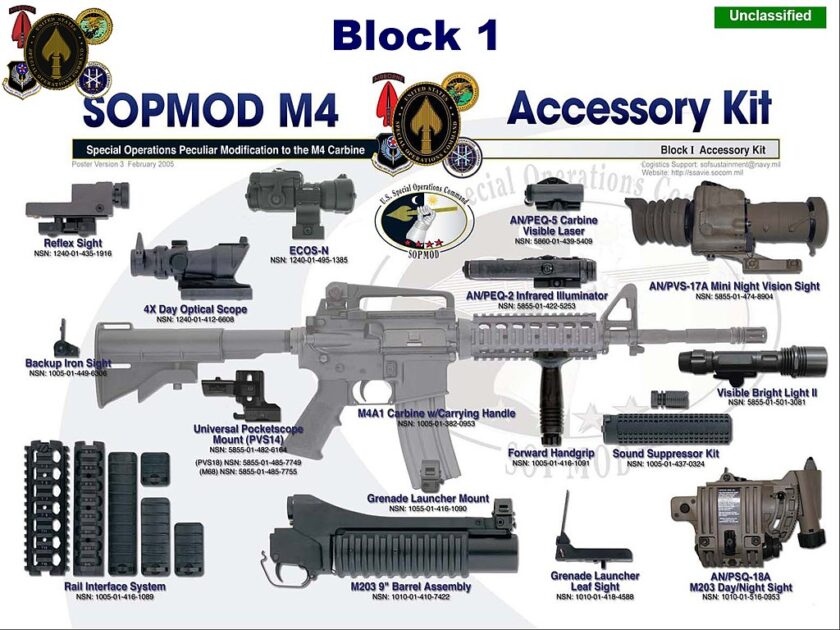
The SOPMOD M4A1 was an arguably better platform for both the ARP and the DAP. It gave the greenside, ARP teams a slightly more maneuverable platform with out giving up a ton in ballistics. It gave the blackside, DAP crew a massive upgrade in ballistic power at the expense of looking slightly less cool, and having a slightly bigger gun.
Except for a brief, early training stage with an M16A2, I spent my entire time in Recon/MARSOC using a common, SOPMOD I M4A1. It sported a very uncool 14.5″ government-profile barrel, bird-cage flash-hider, direct gas impingement, front sight post, and non-free-float KAC quad-rail. For optics I used first an Aimpoint and later an EOTech. It honestly wasn’t much fancier than that. Was this an improvement over the M16A2? Absolutely, but it was an evolution, not a revolution. Are modern, piston-driven, LPVO-equipped rifles better than my old M4? Probably but again, this is an evolution, not revolution.
Other Military Recce Weapons
One major advantage of the military is the range of weapons that can be deployed on a recce operation. You can duplicate some of these in civilian life. Others you can’t, unless you happen to be independently wealthy (if you are independently wealthy and reading this, please consider supporting me on Patreon – I could use your help!).
We’ll go through a few of these weapons because…well, I like guns and you like guns. And this gives me a chance to dig through my old hard drive of military photos. And it might give you some more insight into the recce team and their equipment. Here we go – some of the guns you might see a military recce element carrying.
Light Machine Guns
A huge benefit a military recce team has over whatever team you’re able to put together is a fire support weapon. More often than not, someone (usually the slack man) will be carrying a belt-fed, fire support weapon. One weapon might not seem like it, but it can be a game changer, breaking ambushes and putting heads down while the team breaks contact.
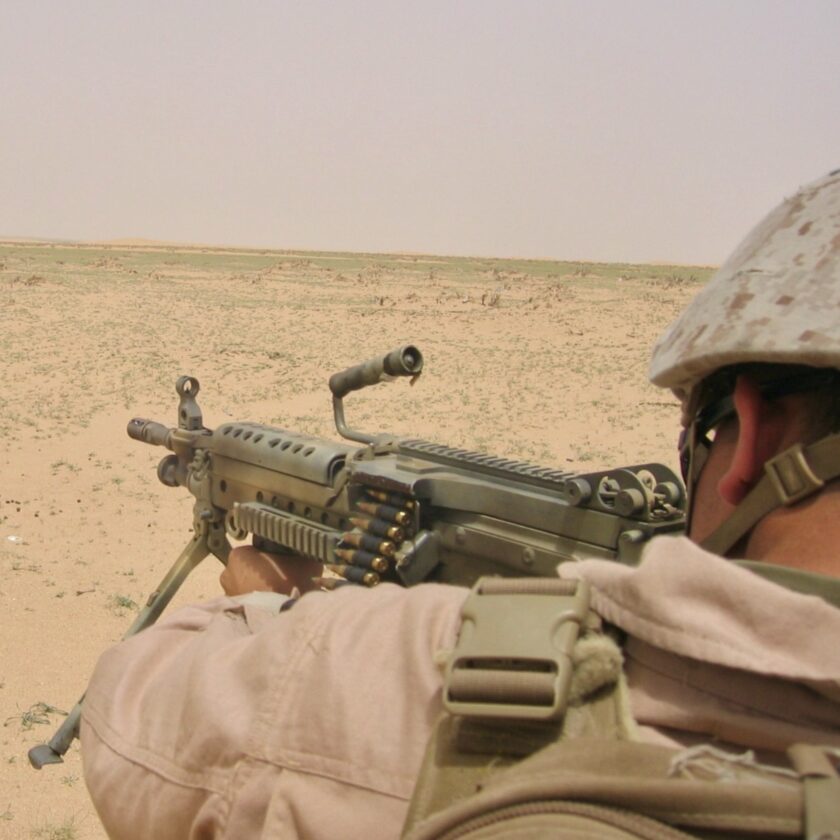
Usually this is in the form of a M249 SAW (Squad Automatic Weapon) or Mk46. Feeding from a 200-round drum or a 100-round “nut sack”, this gun can lay down an awful lot of firepower in a very short amount of time. At 15.5 pounds it’s not unbearably heavy but extremely controllable, even at heavy rates of full-auto fire. I probably have over 15,000 rounds through the SAW and I’m a big, big fan.
Medium Machine Guns
Depending on the particulars of the mission a team may opt for the heavier Mk48, a 7.62×51 version of the Mk46. This is a huge upgrade over the GP machine guns of my day: the M240B/G. Though lighter than the M240, both the Mk48 and the M240 suffer the disadvantage of much heavier ammunition. However, both also have the benefits of range and being able to punch through significantly harder targets.
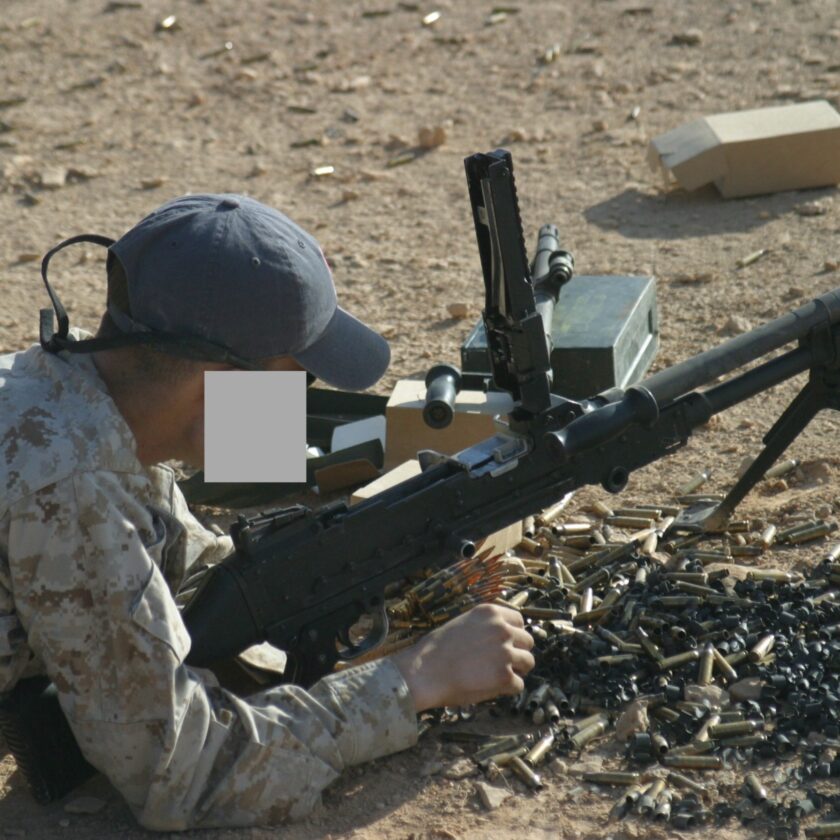
All of these medium machine guns can bring a devastating amount of firepower to bear. Generally the heavy 240B was primarily used when setting up a fixed, defensive position. Weighing close to the same as a Mk46 the Mk48 is much more manueverable.
Sniper Rifles/DM Rifles
A desire for a long-range capability is where the Recce Rifle concept originated. The true Recce Rifle has now been largely supplanted by the Mk12 Special Purpose Rifle (SPR), the Army’s Squad Designated Marksman (SDM) rifle, and the Marine Corps’ Squad Advanced Marksman Rifle (SAM-R). A team member or two armed with these rifles are capable of bringing accurate, long-range fire to bear on the enemy.
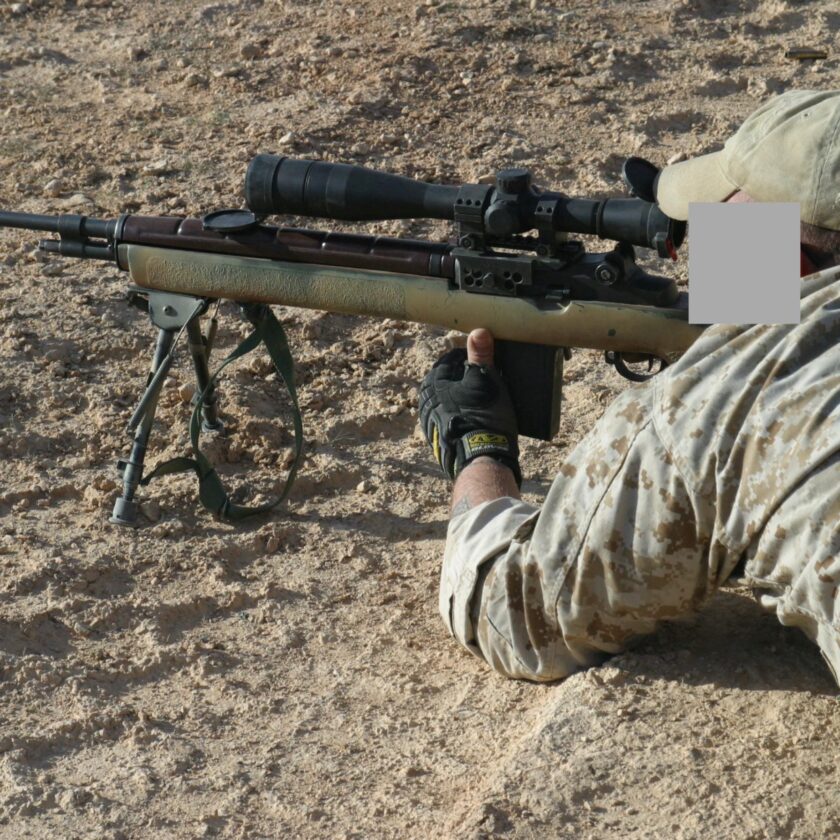
Heavier, 7.62×51 DM rifles may be employed, too. Special operations troops generally have access to the Mk110, an AR10 platform. In my day we had the M14-based Designated Marksman Rifle, or DMR. I was issued one of these guns and took it to Afghanistan. Though I was quite the M14 aficionado (and even owned an M1A at the time), I’m pretty much over it. The M14 is a neat piece of history, but that’s about the kindest thing I’m willing to say about it.
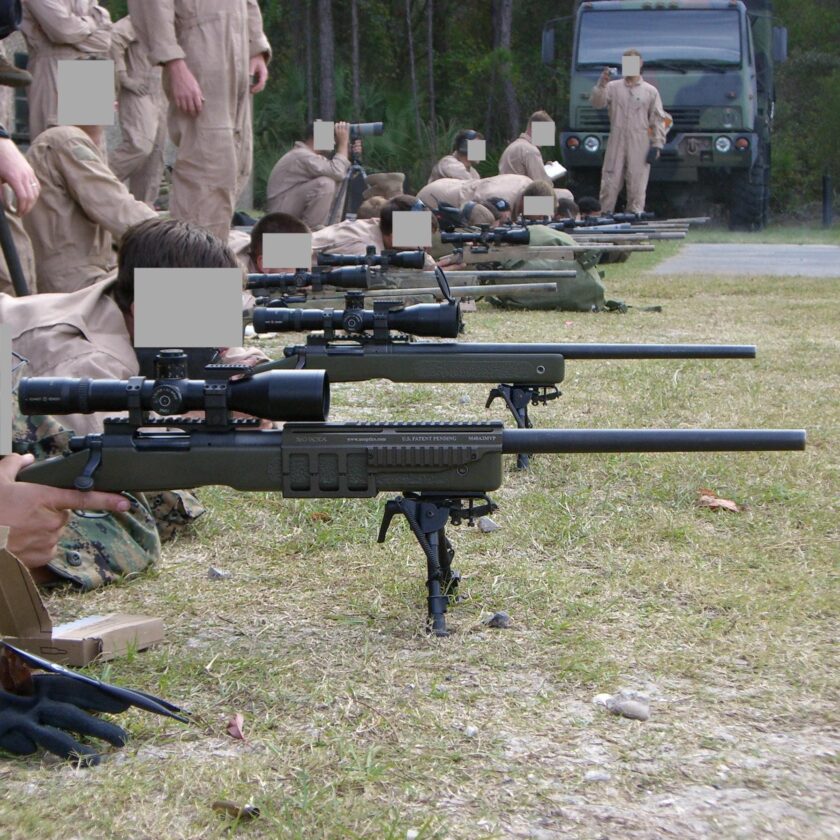
True sniper rifles may also be carried by a recce element. Sniper rifles may be used to initiate an assault (“on the ‘t’ of two”) if the team has been conducting surveillance in support of a raid. They may be employed to strike targets of opportunity – i.e. should the team find themselves looking at a high-value target.
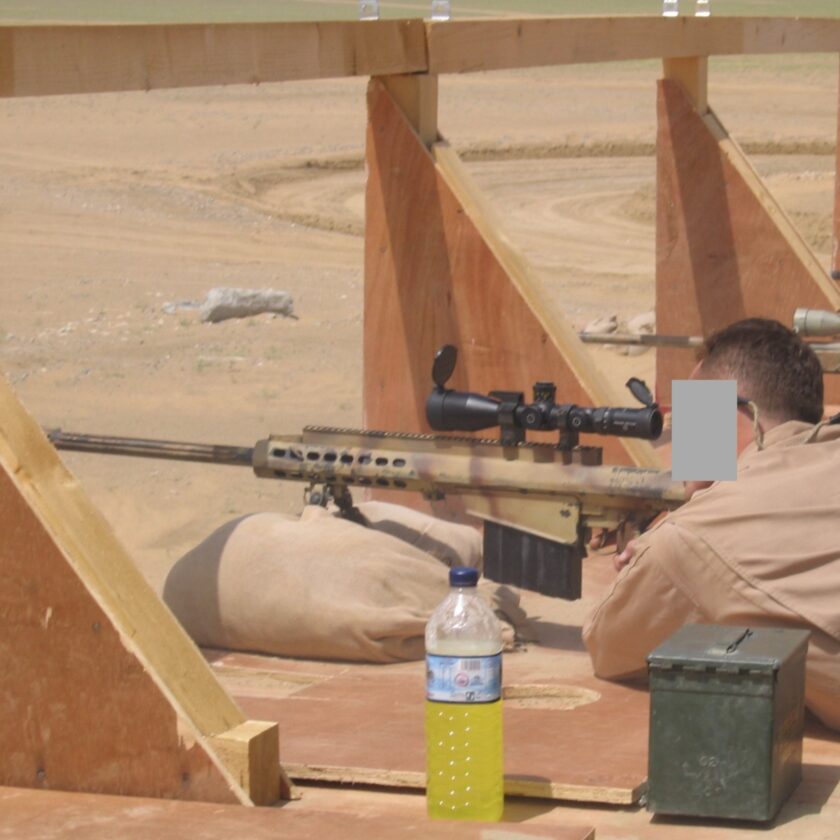
Though not really a recce weapon, it never hurts to throw in a gratuitous gun picture. The .50 caliber Barrett “SASR” (Special Application Scoped Rifle) above is a very specialized weapon. It’s not completely implausible to imagine one on a recce mission, but most of the time you can imagine a more useful way to add 35 pounds to your loadout.
Indirect Fire Weapons
Most recce teams will carry a grenade launcher or two. The ubiquitous M203 grenade launcher is ubiquitous for a reason: it is simple. lightweight, and it works. The M203 provides a really handy, relatively powerful indirect-fire capability. It allows a small team to drop High Explosive (HE) or High Explosive/Dual Purpose (HEDP) rounds into defilade positions or onto lightly armored vehicles (HEDP has a light armor-penetrating capability).
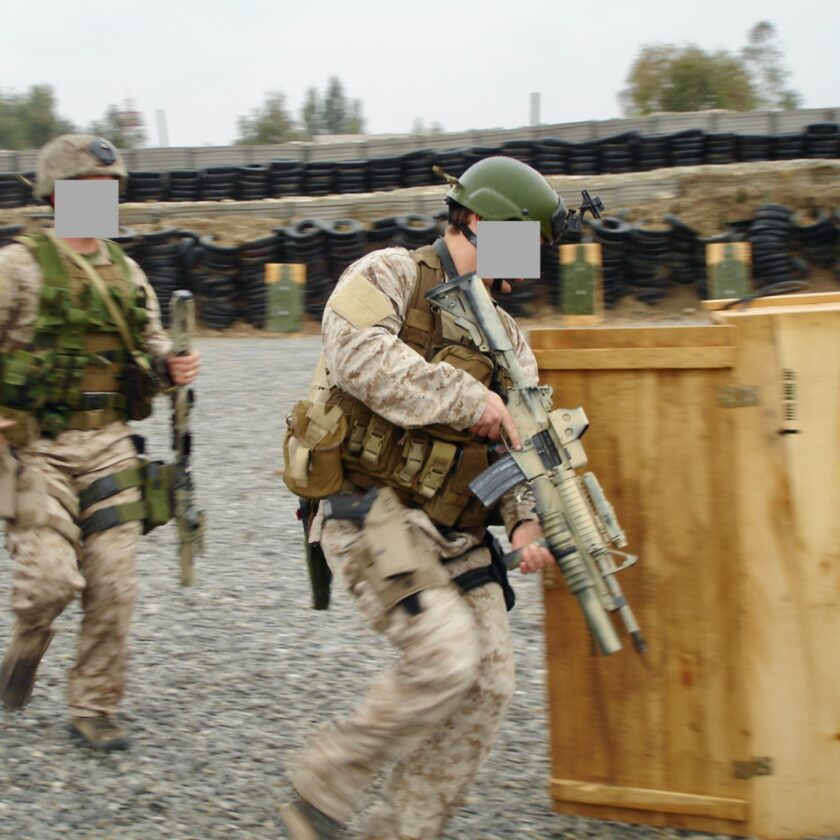
There are also still some of M79 grenade launchers in the inventory. I’ve mostly seen these used as turret guns; they give the turret gunner a convenient, powerful option without turning his whole machine gun. They are super fun guns to shoot, and probably a little more accurate than the M203. I was issued a M79 in Iraq and really liked it.
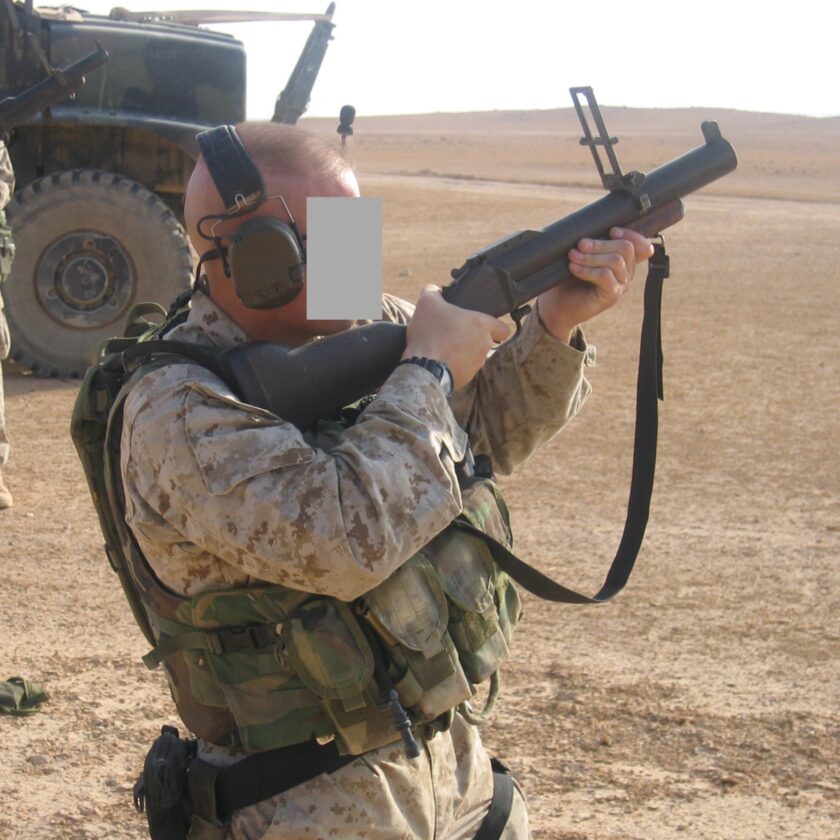
Mortars are sometimes carried, but generally only by larger teams. The 60mm mortar can be fired without a bipod and baseplate; although the tube alone is still extremely heavy at 40 pounds, it is much lighter than larger mortars. In practice I never saw one of these carried by a recce team. In addition to the weight of the tube each round weighs several pounds each. Even though it brings an entirely new class of capability it also comes with a huge maneuverability cost.
Explosives
The military also has something you won’t have access to: reliable, stable, explosive weapons. These generally take a couple of forms: grenades and Claymore mines, but also include rockets. Explosives are used in a variety of other iterations, but we are kind of keeping this to personal weapons systems.
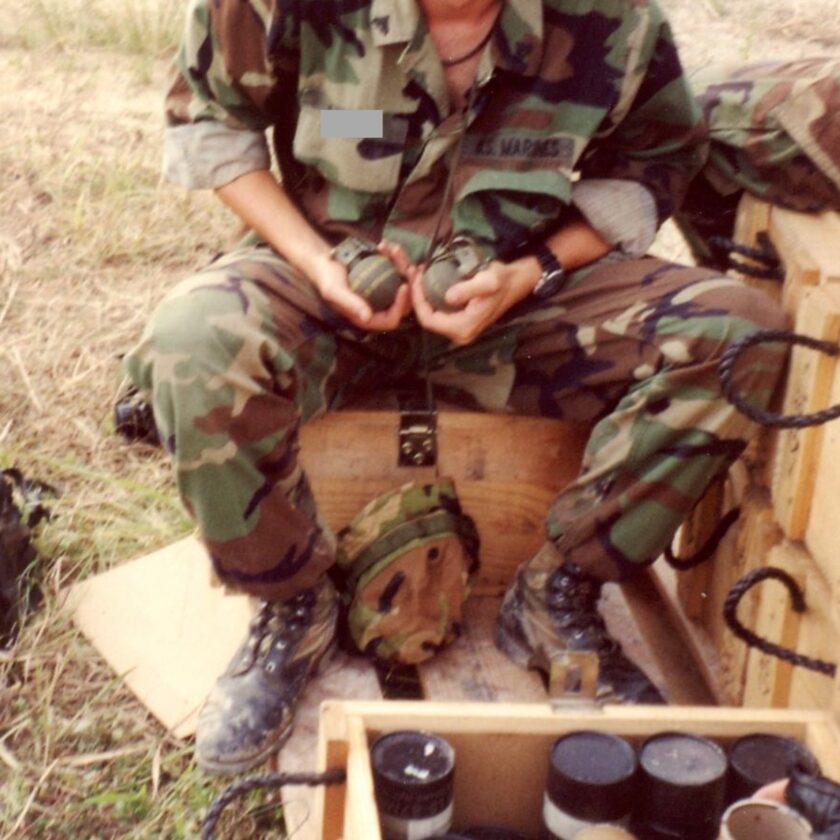
Being issued live ammunition happened sometimes on “training” deployments where there was a credible but remote chance of enemy in areas where we patrolled (i.e. Abu Sayef in the Philippines). You knew you were it was the real deal when the grenades came out. If you’ve never thrown a grenade, they are impressive, and absolutely nothing like the big, slow fireball of the movies. They issue a very loud, percussive “CRUMP” that you feel in your chest. You don’t want one going off anywhere near you.
The Claymore mine was also a staple of Recon life. I have only “clacked off” one Claymore in my life and it was in eye-opening experience. Holy shit – Claymores are incredibly powerful weapons. If you don’t know, the Claymore is a directional, command-detonated mine that sends out a lethal spray of about 700 steel ball bearings. Like grenades, these only get issued out when shit gets really real.
Rockets
And finally, rockets. Mostly these were of two types: AT4s like the one shown below, and M72 LAW rockets. These are sometimes used as a light anti-armor capability and to initiate ambushes.
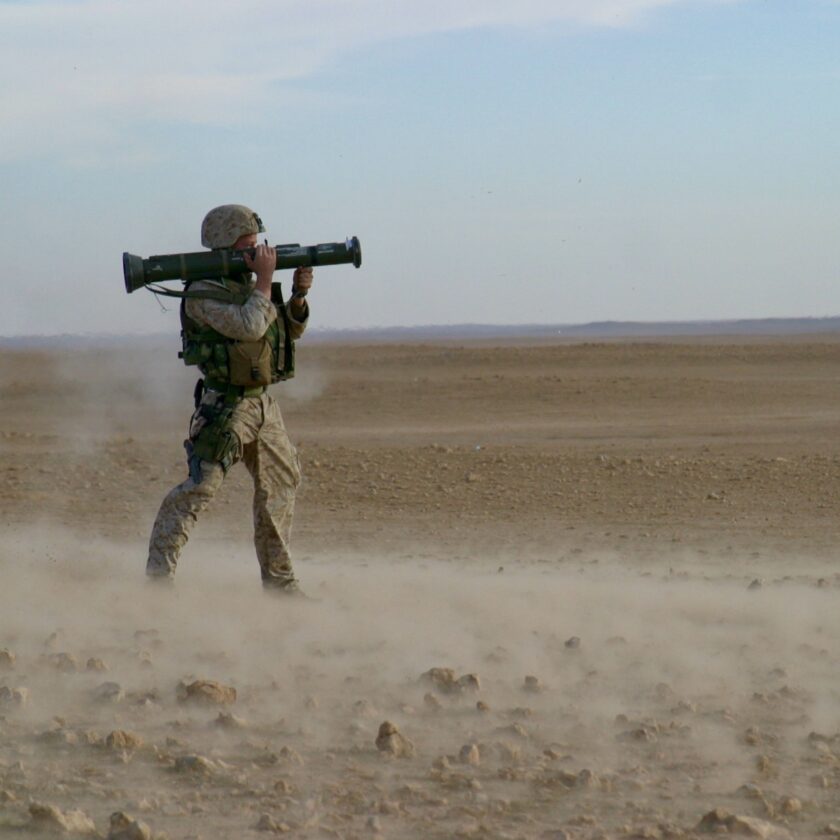
Though I would much prefer to carry the lighter, telescoping LAW all day long and twice on Tuesday, the AT4 was usually the only thing available when rockets were requested by teams I was on. With a solid hit an AT4 is an incredibly formidable weapon, but I’ve also see the projectiles skip off the sand and out into oblivion without detonating.
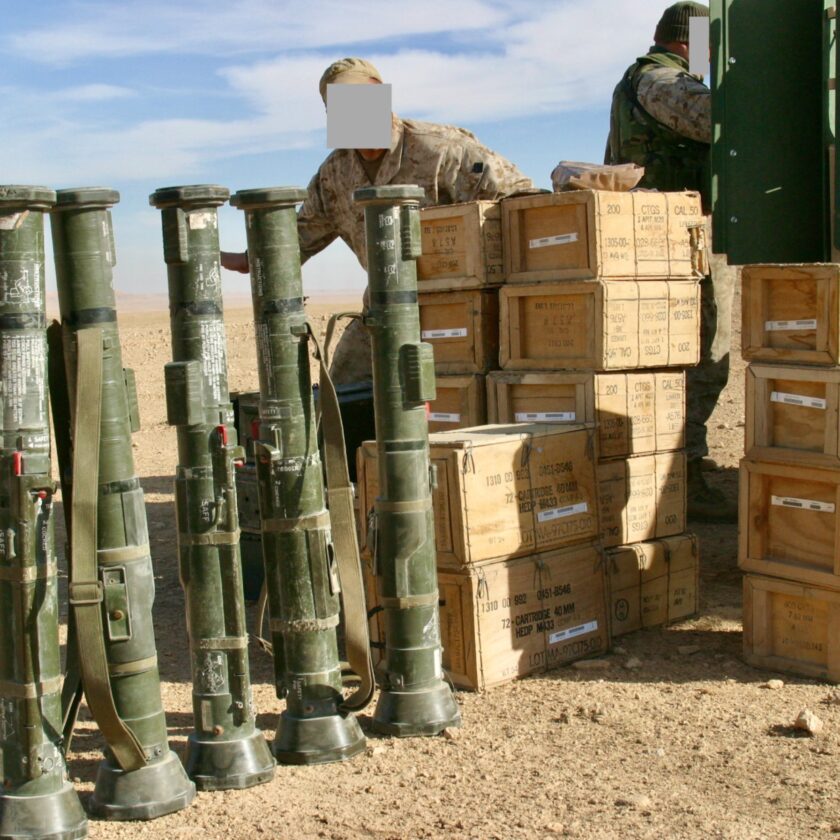
Most of this is a moot point, because as private citizens we will have to rely only on the ultimate implement of battle: the rifle. Let’s get into it.
The Civilian Recce Rifle
That’s all well and good and interesting, but let’s talk about your rifle. Your “little-r” recce rifle can be just as capable as a military M4 with very few accessories/modifications. Assuming, of course, it is of high quality, reliable, and durable.
And let’s get this out of the way: if you really want that SOCOM-16 or a new LMT AR or are looking for a reason to own a Scout Rifle, you don’t need permission from some internet recce article – just go for it! You probably don’t need it, though. Here is where I am going to disappoint some people, because – back to the beginning – you don’t need a super special rifle for recce. Let’s talk about what kind of rifle makes a good recce rifle.
Honestly, I think you should, as my dad would say, “dance with the one that brung ya.” The best recce rifle is the rifle you’re really good with. It’s what you have training, practice, and DOPE on. Having a rifle with a barrel two inches longer or shorter, and a different stock, or a brand-new optic isn’t going to be a game-changer for you. If your skill is so high-level that a slightly different AR configuration is a game-changer, you probably aren’t reading anything I write looking for tips.
That said there are a few things about your rifle that are kind of important.
AR Platform
First, life will be much easier for you if your rifle is an AR platform. If it uses AR/STANAG magazines, you will have a much easier time finding magazine pouches and other support gear that works. An AR is capable of laying down a decent level of firepower should have to initiate a break-contact drill and fight your way out of a situation.
If you have an AR you will be able to interchange magazines with others on your team. The AR platform is also generally very reliable. Of course you should ascertain reliability right now and know your weapon is reliable. Keeping an AR running is easy, simple, and cheap as parts are drop-in, and widely available and knowledgeable gunsmiths are everywhere. The AR pretty much wins hands-down. If you’re a FAL guy or AK guy or whatever, you should probably think about becoming an AR guy, too…because everyone else on your block probably is.
AR Attributes
Not only should you have an AR platform, it should be reliable. Your gun should run all day long. I’m a big fan of BCM rifles, but just about any mil-spec AR should be pretty reliable. But don’t trust it to be – get out and make sure it is. Your rifle should also be durable. I would shy away from ultra-light competition rifles, target-style triggers, and the like. I’d recommend sticking with good, old fashioned, combat-proven components.
If your budget is limited (and whose isn’t) I’d spend money on a high quality rifle with iron sights before I’d buy an OK rifle with a OK optic. the rifle must be monotonously reliable and durable in the face of rain, dirt, being dropped and dragged and submerged.
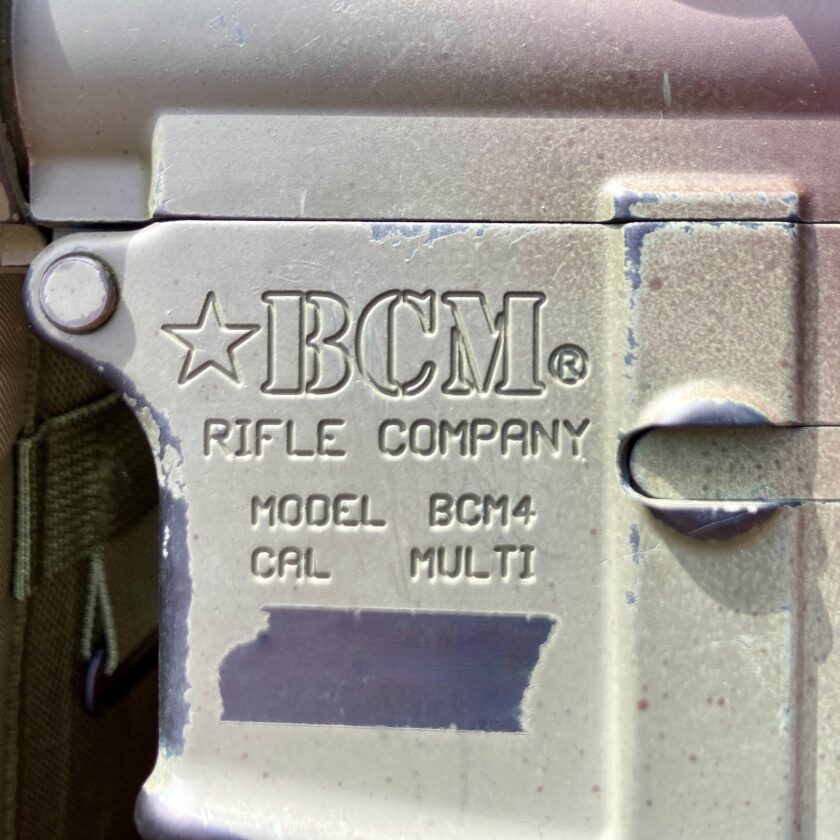
Your rifle should also be as lightweight as possible while retaining durability, accuracy, and reliability. You have to carry it, after all. This means hanging the minimum crap off of it, while still getting the capability you need. As I was reading this article Matt Robertson at Everyday Marksman wrote an article on this very topic. I really recommend reading his thoughts.
Beyond that you really don’t need to get crazy with rifle specs. The difference between a 14.5″ barrel and an 18″ barrel are going to be all but unnoticeable to 95% of users. Again, if you want to build a dedicated “recce rifle” go ahead, but it’s probably not going to change your life, and that money would probably be better spent paying down debt, building a reserve of cash, or adding to your savings account. And while I’m at it, with regards to barrel length you’ll be just fine with a 20″ M16-style AR if that’s what you already own.
So what do you put on the rifle?
Recce Rifle Accessories
Optics turned into such a beast I made it its own section, further down the page. This section is going to cover other bolt-ons and accessories you may want to have available for your rifle.
Accessory 1: AR Operator
The first thing your rifle should have is a high-quality AR operator. The AR operator should be physically fit. He should be able to get the rifle where it needs to go, over any terrain and in any weather, with energy and focus to put metal on meat once he gets there. Recce patrolling is hard work, and the operator should be able to run the rifle effectively at any point during the patrol – from the kickoff of insert to the moment that extract has been completed and he is back behind friendly lines. Actually he should be able to go further than this because things don’t always go as planned.
Additionally the AR operator should be highly skilled. Skill is the blend good training, frequent practice, and ideally some experience. Ideally he should attend several days of training per year and practice several days a month. He should regularly shoot at short and long, known and unknown distance. Training should be varied and include a mix of extreme close-range, and mid- to long-range shooting. He should know holdovers and should know HIS rifle. A physically fit, skilled operator is absolutely the most important thing you can give the rifle. Nothing else will come even close to it in impact.
If your rifle doesn’t have a highly competent operator a great place to start is Green Eyes, Black Rifles by Kyle Lamb. Reading a book isn’t a substitute for training but it will give you some things to practice. Then find a training class. Practice. Work out. Repeat.
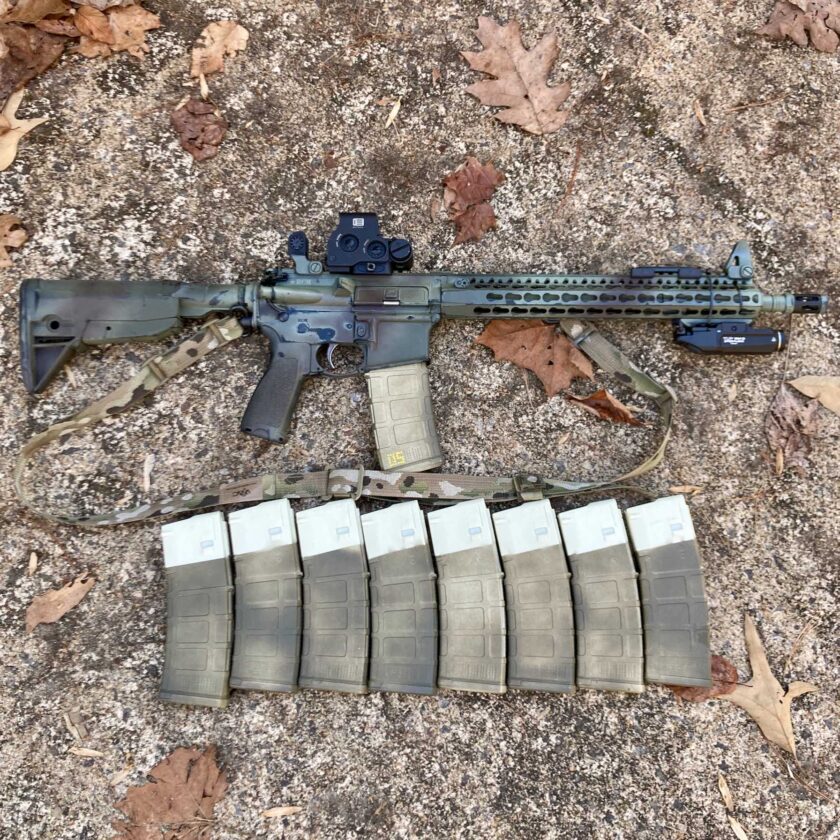
Accessory 2: Sling
Carrying a rifle constantly is hard work. I came on the scene before two-point slings were widely known. Much of my recce patrolling was done with no sling at all. If I had it to do over again I would absolutely patrol with a two-point sling. I’m a fan of the VTAC sling – in my opinion it is the best two-point out there. The VCAS two-point sling has a lot of knowledgeable fans, too.
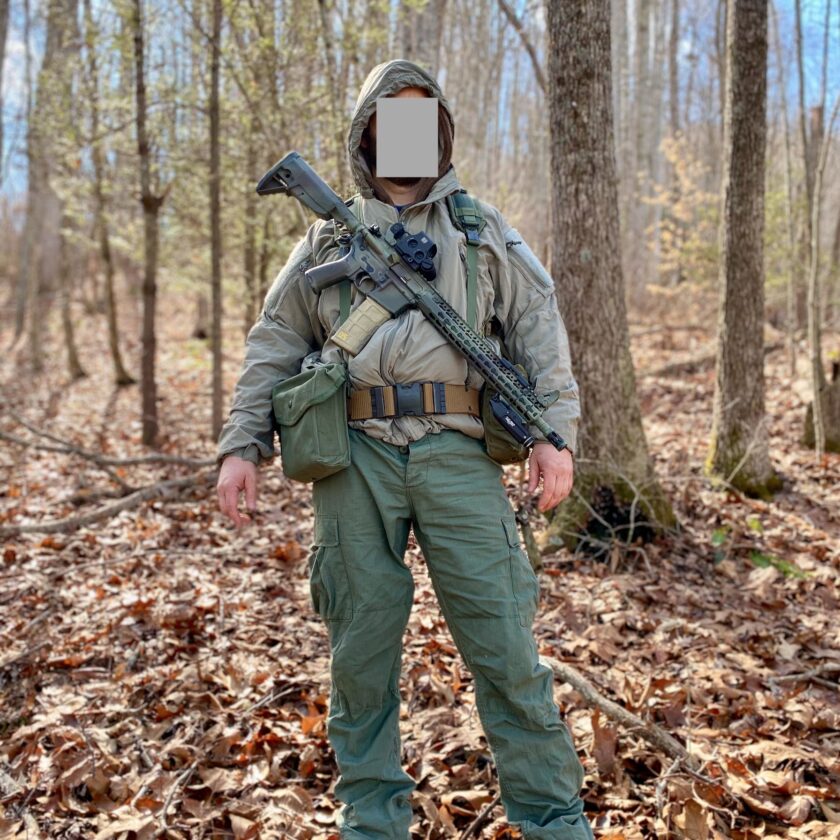
Not only does a sling make the act of carrying the rifle slightly less onerous, it frees the hands for other tasks. Sometimes these tasks are pulling oneself up a hill, setting up an antenna, or just taking a piss. Without a sling, where do you put your rifle? Being able to hands-free your rifle just simplifies everything. A sling also makes it less likely that the rifle is out of arm’s reach. If you take a tumble down a hill your rifle is going to stay with you. With the sling literally attached to your body you aren’t going to leave your gun very far away.
Accessory 3: Cleaning Gear
You don’t need to keep the gun squeaky clean, but keeping it running is imperative. So you will need some cleaning equipment. You don’t need a lot of stuff – maybe some CLP, a toothbrush, and a section of rag. Obviously the more stuff you have the better a job you’ll be able to do, but that’s generally enough to keep the gun running. And my opinion is keep the gun wet. An AR – any AR – will run pretty well if kept well lubricated.
The one other thing you may want to strongly consider is a collapsible cleaning rod. This enables you to clear the bore should you take a spill in the snow or mud and plug up the barrel. A cleaning rod can also help you clear a stuck case. Though not quite as easy to carry as a BoreSnake it’s more versatile and can fix a couple more problems.
You’ve also heard the old saying, “amateurs talk tactics, dilettantes talk strategy, professionals talk logistics.” Though this stuff doesn’t come out on patrol with you, you also need to think about the logistics of maintaining your recce rifle. You should be thinking about spare parts and maybe even a spare rifle.
Accessory 4: Magazines & Ammunition
The AR feeds from the magazine so you’ll need plenty of magazines. I happen to really like PMAGs. but even Okay Industries aluminum GI mags work absolutely fine. I would recommend first purchasing enough magazines to fill your patrol rig (I recommend 6-8 magazines), then double that for a set of training magazines. PMAGs are inexpensive and work so reliably the SOCOM and the Marine Corps have adopted them, but they are bulkier than GI mags. And for the record, GI aluminum mags ain’t broke. All other things being equal, at almost the same price as PMAGs, I’d spend my dollar on PMAGs.
Back to the logistics thing, you also need to think about ammunition. The logistics of being your own ASP (ammo supply point) needs addressing now (well, preferably it needed addressing in like 2016, but…). I’m not going to speculate on a number, but if you’re REALLY thinking you might need to do recce you should probably have a reasonable amount of ammo to support regular training, as well as any engagements you plan to get into.
Accessory 5: Flashlights…Maybe?
Finally there’s a whole bunch of other accessories you can hang on your gun. Leading among these is a flashlight. I have a flashlight on my AR because it’s a general purpose AR, not a recce-specific rifle. I don’t think there is anything at all wrong with having a light on a recce rifle, but if I you do, it should have a lockout or a protected switch so you don’t have white-light NDs in the woods.
If you do have a white-light, I would recommend something robust, and with some extended throw since it is intended to be used at a good distance. Probably the ideal light is the Modlite OKW which is designed for extreme throw. The Arisaka E2XT is a close second, and it looks like the The Cloud Defensive REIN 2.0 might make the list, too.
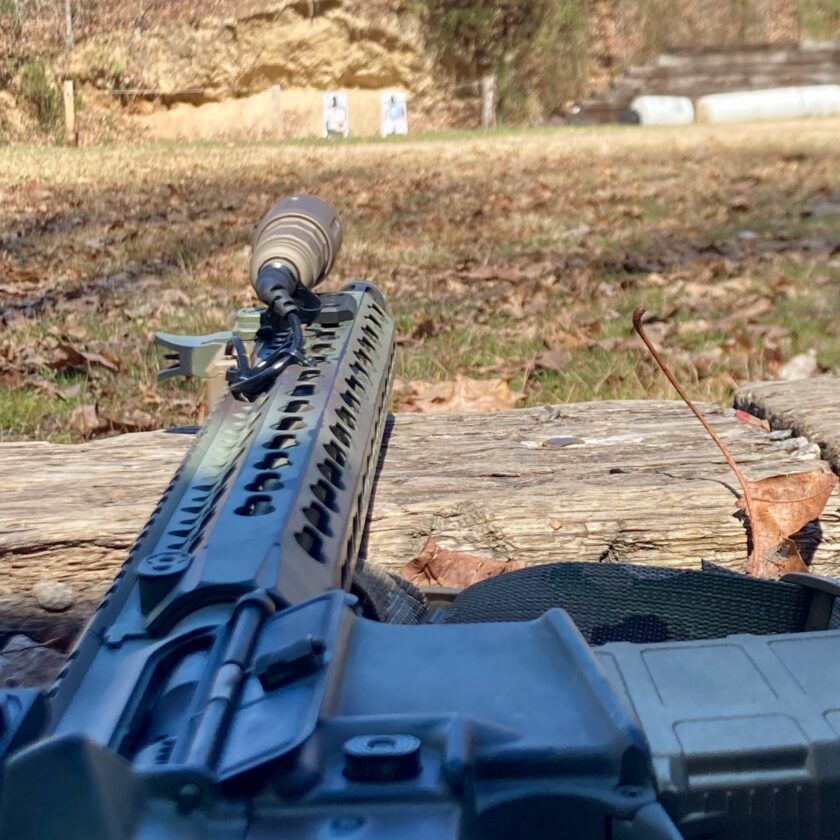
Admittedly this article got me to consider a flashlight upgrade. I recently purchased something a bit more durable and general purpose for my rifle: the Modlite PLHv2 which has awesome, long-range, outdoor throw, but good spill for indoor employment.
Other Accessories
There’s a ton of other stuff you can hang on your rifle. Stuff like “broom sticks” (vertical fore grips), angled fore grips, lasers, coffee mugs, etc. I would recommend keeping these to a prudent minimum. At the end of the day, think about what you need and don’t need. If something is hanging off your gun that you don’t already use, think about how necessary it really is. If you can get rid of it, do it.
Optics
This is my least favorite part of this article to write. First, I’m not an optics snob, choosing instead to practice what I preach and use something that is almost certainly inferior (an EOTech), but with which I have vast training and experience. Secondly, your choice of optic matters way, way less than your level of skill. If you suck with irons sights you’ll suck less with an optic…but you’ll still suck. If you are going to go with an optic on your recce rifle I would recommend the following, in (roughly, maybe?) my order of preference: LPVO, ELCAN Spectre, ACOG-type fixed-power optic, red dot optic, or iron sights. Let’s talk briefly to each.
Real quick though, let’s put optics in perspective. If you have $1,000 total to spend, I’d rather you spend $1,000 on a durable, reliable rifle with iron sights than spend $600 on a mediocre rifle and a $400 optic. A fancy optic isn’t very useful on a rifle that chokes, so a durable, reliable rifle is more important than optics. A fancy optic looks cool, but a reliable rifle (with a skilled operator) actually is cool.
LPVO
The low-powered variable optic (LPVO)(usually something like 1-6 power or something like that) is the new darling of general purpose carbines. If you’ve to the cash for an LPVO, it’s definitely something you should consdier. You’ll be a little better off than guys with irons/red dots when it comes to viewing/hitting things at a distance, and better than guys with traditional rifle scopes when it comes to close-in work.
Unfortunately LPVOs come with a price: size and weight. They do more, but they sit higher on the gun and weight more than red dots (i.e. EOTech or AimPoint), fixed-power optics (i.e. the ACOG), and dual-role optics (i.e. the ELCAN Spectre). The height and weight really changes the way the gun carries. This really comes into play when carrying the rifle long distances over rough terrain and significant elevation changes. I know it probably doesn’t seem like much when you’re carrying the gun around the house but on day 3 of a recce patrol it may be a different story.
Also consider your environment. If you live in a rural environment that is heavily, densely wooded (in the deep south, for instance) do you really need a long-distance capability, or is a red dot just fine?
Fixed Power and Dual-Role Optics
I am a huge fan of the “dual role” optic, as typified by the ELCAN Spectre DR. I first came across this optic in 2007 when being on a team field specifically to test the SCAR for a few weeks. We abused the SCAR in every way imaginable, swam it, fast-roped it, rucked with it, and shot it a lot to ensure it could withstand some abuse. Right alongside it (actually, along its top) was the ELCAN Specter DR. SOF didn’t full-on adopt the SCAR, but they did adopt the ELCAN Spectre DR.
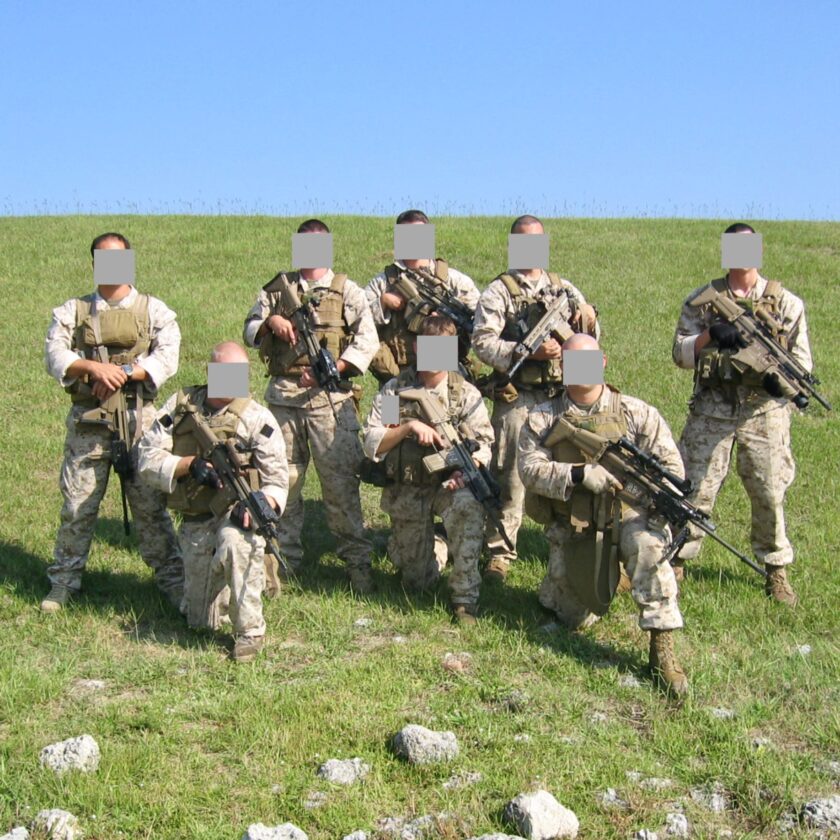
The Spectre allows you to switch from a zero magnification red dot to a 4x scope at the throw of a lever. Though some complain about the external adjustment (adjustments move the whole optic in its mount) the ELCAN has proven itself tough and reliable. If I had the cash, this is probably what I’d put on my carbine.
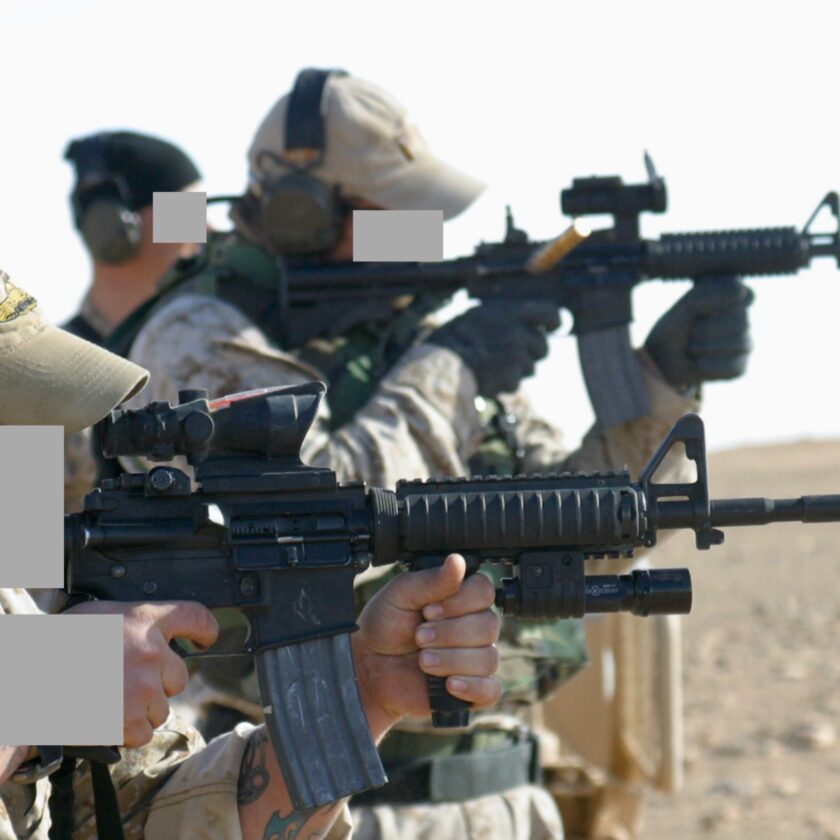
Another excellent option is the fixed-power telescopic sight exemplified by the ACOG. These cost about half as much as the ELCAN and have also proven themselves combat-worthy. I don’t happen to really like the ACOG. I was given the option of using one in most platoons I was in and passed – just not my cup of tea.
Red Dot Optics
Another option is the red dot optic (RDO) like the Aimpoint or EOTech. An EOTech is what my carbine currently wears. I hear you – if it’s my least favorite, why is it what I use? Frankly, I can’t justify the cost of a “recce” optic because I will probably never do recce again in my life. As an average citizen your real-life odds of a few close-in shots, while still extremely remote, are more likely than conducting patrols…just to keep things in perspective.
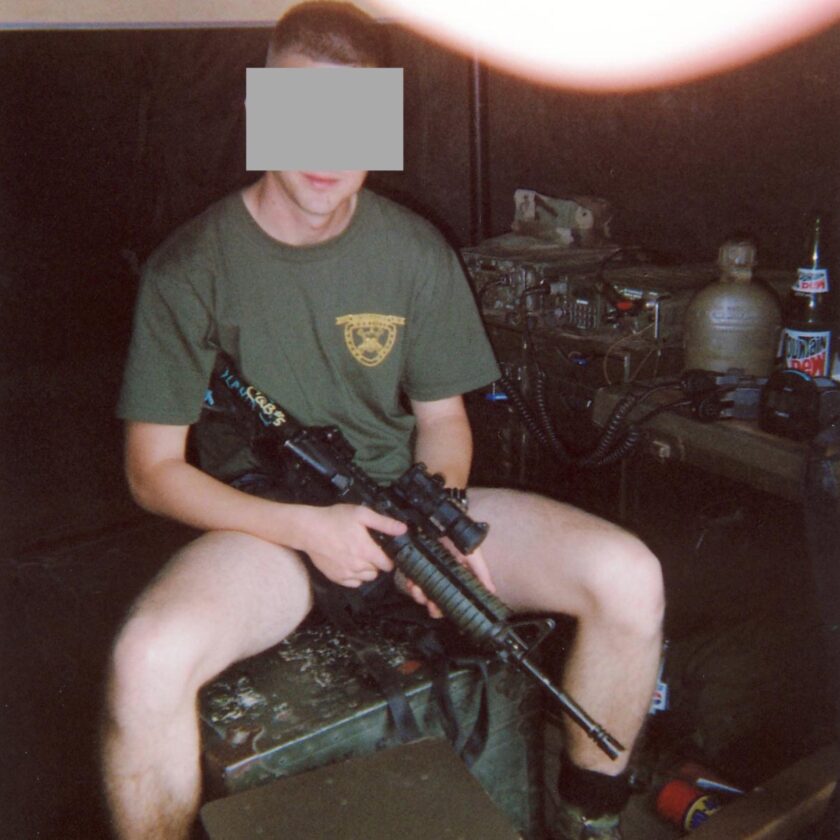
And you can still shoot a long way with a red dot optic. One trick is to turn the intensity down as low as it will go and remain visible – this makes the dot much more precise. Where red dots don’t help is in being able to increase observational ability. But if you can make hits at 500 with a LPVO, you can also very likely make hits with a red dot optic. It might be slower and more error prone but you’re not limited to shots at 50 yards.
I have personally put rounds on target at 700 yards with an EOTech at a high-angle marksmanship course. I wouldn’t be money on my ability to do it on demand now but with training and practice it is absolutely possible.
Iron Sights
If your budget doesn’t allow for an expensive optic, fear not. Iron sights are capable of more than you can imagine. In fact, I’d take pretty much any dude who has actually spent a few years in any sort of special operations with an iron-sight M16A2 over an average Joe with zero (or even modest) training and a $3,000 optic on a $2,500 rifle. For perspective, I qualified half a dozen times in the Marine Corps with irons, firing at 200, 300, and 500 yards. I can get some work done with iron sights.
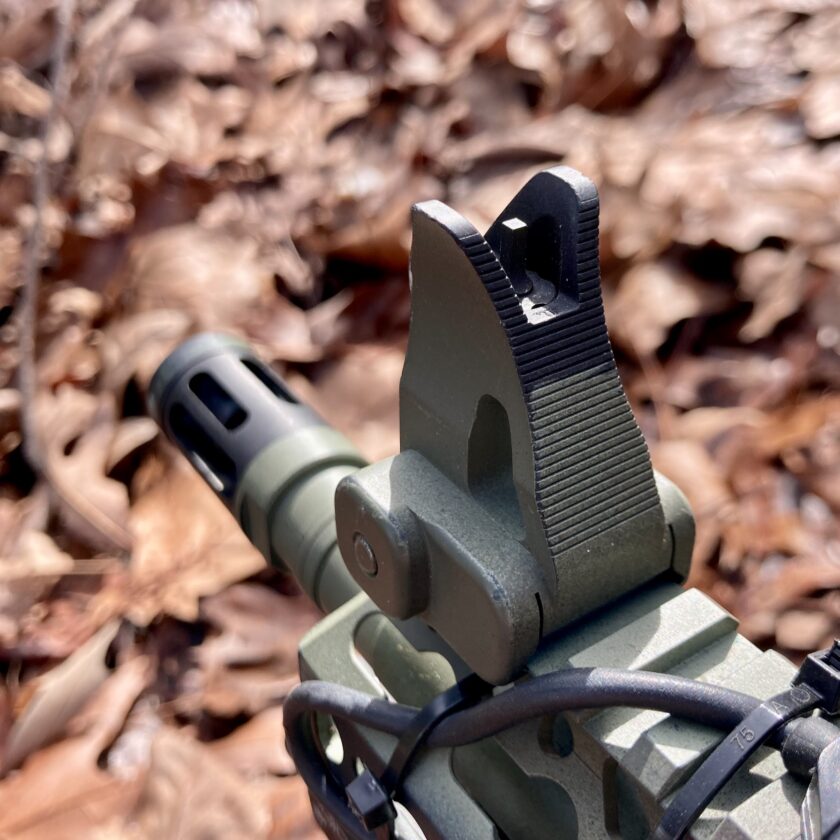
I like iron sights even on my rifles with optics. Those of you with telescopic sights will probably prefer fold-down iron sights. The steel Magpul steel BUIS are my favorite in this category. For those of you relying on irons, or using irons co-witnessed with an optic, may choose fixed irons. My absolute, hands-down favorite rear is LMT’s Tactical Rear sight. It’s not cheap but it has full adjustment capability. I currently run Troy fixed backup irons with a “lower third” co-witness.
The man who trains with a sword beats the man who plays with a stick. Not to beat a dead horse but the optic you have is largely irrelevant if you lack skill. If you have skill, the iron-sighted rifle can be extremely deadly.
The Expensive Accessories
Then there is a class of accessory that is very nice to have, but I’m not sure the cost is actually justified in most cases. Accessories in this class include things like IR lasers and suppressors. To be clear, there is nothing wrong with these tools and no reason you shouldn’t be able to own them. They do impose tremendous cost, however. My personal feeling is that you shouldn’t even consider these items until you are completely debt-free and have a year’s worth of expenses saved.
The first cost is financial. A night-vision optic worth using is going to cost a few thousand dollars – I can’t find really anything comparable to a AN/PVS-14 for less than $2,500. I’m sure there are cheaper night vision devices out there, but is a $1,000 device that craps out the first time it gets wet a sound investment? I’m inclined to say “no.” Night vision goggles also require a helmet for comfortable use, increasing your cost and the load you have to carry.
Sights like the DBAL and other IR lasers are also expensive, with any one I’d be comfortable using costing at least $1,000 (and most more like $1,500). And if you don’t have NVGs they’re pretty much pointless, so we’re looking at close to $5,000 for a night-vision capability. That’s pretty costly. I’d have to think that money is probably better off in your savings account or paid toward your mortgage.
A suppressor isn’t quite as expensive (usually) but the cheaper ones also have a cost. They add length to the gun, and weight out front where it negatively influences the balance of the rifle. While I think a suppressor may be a worthwhile, standalone tool, the length, weight, and balance penalties must be considered.
Pistols
This is going to be really short section: I always carried a pistol on direct-action ops, but never carried a pistol on a reconnaissance patrol. A pistol is a defensive, close-range weapon. Pistols serve a couple purposes: they give us something when we can’t carry a rifle, and they provide a backup in case the rifle goes down at very close range. When conducting a recce we can carry a rifle, voiding the first reason. We also aren’t fighting in close quarters, greatly lessening the value of the second.
For CQB or mixed urban ops – yeah, I’d carry a pistol. Some units and individual operators carry pistols on recce operations. Personally I would probably rather expend that weight on a couple extra magazines.
However, If you want to carry a pistol on a recce operation go for it! I’m not the boss of you. However, I would advise you to spend a day or two under the tick before committing, though. The combination of rucksack, friction from wet, sandy clothing, exhaustion from “breaking brush” all night can combine to make you want to cut weight anywhere and everywhere you can.
Closing Thoughts on the Recce Rifle
Just to quickly recap, here’s how you should allocate your expenditures:
- Prioritize a reliable, dependable rifle. Brands like BCM and Colt are highly recommended.
- Next, ensure you have a high-quality set of iron sights, folders if you plan to use a magnified optic.
- Add magazines and ammo consistently and methodically (you will never stop adding these).
- Make sure you have cleaning gear and lube. This is non-negotiable.
- Invest in a two-point sling like the VTAC or VCAS slings.
- Consider an optic. Ensure you have covered down on the items list above first.
- Through out this process invest in training and practice. Attend classes, go to the range with a plan and some defined drills. Dry practice regularly and work on things like malfunction drills and mag changes. Attend a competition occasionally.
This will set you up very nicely. You can add a lot more stuff to this list if you want, but a good rifle with irons and a high quality optic, cleaning gear, a sling, and plenty of mags and ammo is a force to be reckoned with… in the hands of a skilled operator.





